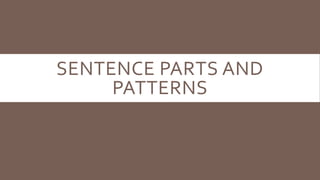Sentence parts and patterns
•Transferir como PPTX, PDF•
3 gostaram•272 visualizações
This document provides an overview of basic sentence patterns and parts, including the subject, verb, direct object, and indirect object. It explains how to identify each part and gives examples of four common sentence patterns: Subject + Verb, Subject + Verb + Direct Object, Subject + Verb + Indirect Object + Direct Object, and Subject + Linking Verb + Subject Complement. The document concludes with a practice identifying the pattern for several example sentences.
Denunciar
Compartilhar
Denunciar
Compartilhar

Recomendados
Basic sentence patterns and traditional classification of sentences surigao

Basic sentence patterns and traditional classification of sentences surigaoJohn Paul George Cardenas
Recomendados
Basic sentence patterns and traditional classification of sentences surigao

Basic sentence patterns and traditional classification of sentences surigaoJohn Paul George Cardenas
Mais conteúdo relacionado
Mais procurados
Mais procurados (20)
Sentence Patterns - Grammar Lesson for Grades 5 and 6

Sentence Patterns - Grammar Lesson for Grades 5 and 6
Semelhante a Sentence parts and patterns
Semelhante a Sentence parts and patterns (20)
Mais de Cristine Joy Tacardon Laforga
Mais de Cristine Joy Tacardon Laforga (13)
Último
Mattingly "AI & Prompt Design: Structured Data, Assistants, & RAG"

Mattingly "AI & Prompt Design: Structured Data, Assistants, & RAG"National Information Standards Organization (NISO)
Explore beautiful and ugly buildings. Mathematics helps us create beautiful d...

Explore beautiful and ugly buildings. Mathematics helps us create beautiful d...christianmathematics
Último (20)
Unit-V; Pricing (Pharma Marketing Management).pptx

Unit-V; Pricing (Pharma Marketing Management).pptx
Z Score,T Score, Percential Rank and Box Plot Graph

Z Score,T Score, Percential Rank and Box Plot Graph
Seal of Good Local Governance (SGLG) 2024Final.pptx

Seal of Good Local Governance (SGLG) 2024Final.pptx
Measures of Dispersion and Variability: Range, QD, AD and SD

Measures of Dispersion and Variability: Range, QD, AD and SD
Mattingly "AI & Prompt Design: Structured Data, Assistants, & RAG"

Mattingly "AI & Prompt Design: Structured Data, Assistants, & RAG"
Ecological Succession. ( ECOSYSTEM, B. Pharmacy, 1st Year, Sem-II, Environmen...

Ecological Succession. ( ECOSYSTEM, B. Pharmacy, 1st Year, Sem-II, Environmen...
Mixin Classes in Odoo 17 How to Extend Models Using Mixin Classes

Mixin Classes in Odoo 17 How to Extend Models Using Mixin Classes
Measures of Central Tendency: Mean, Median and Mode

Measures of Central Tendency: Mean, Median and Mode
Russian Escort Service in Delhi 11k Hotel Foreigner Russian Call Girls in Delhi

Russian Escort Service in Delhi 11k Hotel Foreigner Russian Call Girls in Delhi
Explore beautiful and ugly buildings. Mathematics helps us create beautiful d...

Explore beautiful and ugly buildings. Mathematics helps us create beautiful d...
Sentence parts and patterns
- 2. START with theVERB! To find the predicate: locate an action verb, linking verb, or verb phrase NEXT… look for the SUBJECT. To find the subject: Ask who/what [verb]? A sentence may have a DIRECT OBJECT, INDIRECT OBJECT, or BOTH! To find the direct object: Ask [verb] what? To find the indirect object:Ask [verb] to/for whom/what? HOW TO FIND THE SENTENCE PARTS
- 3. PATTERN #1: SUBJECT + VERB In its simplest form, a sentence has two parts: a subject and a verb. They express a complete thought when they are together. Subject + Verb PATTERN #1: SUBJECT +VERB Options: noun or pronoun Shows an action or a state of being Options: action verb, linking verb, or verb phrase (helping verb + main verb) Answers who/what is doing the action?
- 4. PATTERN 2: SUBJECT + VERB + DIRECT OBJECT Subject + Verb + Direct Object ACTION verb OR VERB PHRASE (helping verb + action verb) Receives the action of the verb Ask yourself: [verb] what? Who or What? Noun or pronoun
- 5. PATTERN #3: Subject + Verb + Indirect Object + Direct Object SUBJECT +VERB + INDIRECT OBJECT + DIRECT OBJECT Who or What? Noun or pronoun ACTION verb OR VERB PHRASE (helping verb + action verb) Identifies to or for whom or what the action of the verb is performed Ask yourself: [verb] to/for whom/what? Receives the action of the verb Ask yourself: [verb] what
- 6. PATTERN #4: Subject + Linking Verb + Subject Complement SUBJECT + LINKING VERB + SUBJECT COMPLEMENT “To be” verbs like am, is, are, was, were, etc. Sensory verbs like appear, feel, grow, look, etc. the adjective OR noun that follows a linking verb. complement = completes the subject
- 7. PRACTICE: LABEL EACH SENTENCE WITH ITS SENTENCE PATTERN: 1. Books convey ideas. 2. Dolphins leap. 3. The pitcher threw the catcher a curve ball. 4. John hates lima beans. 5. The sea is beautiful even in winter. 6. The writer sold his publisher a three-part story. 7. You seem worried. 8. Elizabeth will swim. S V IO DO Example: The mother gave her children a snack.